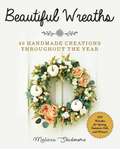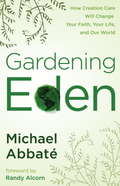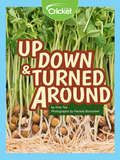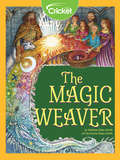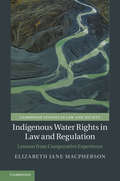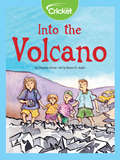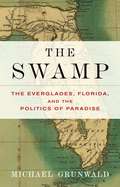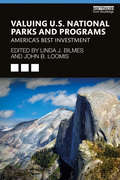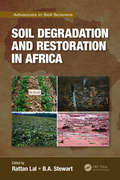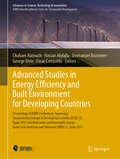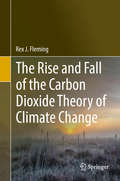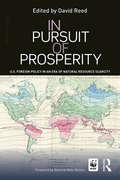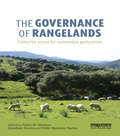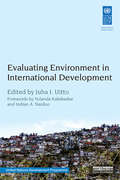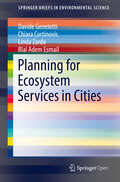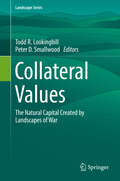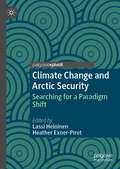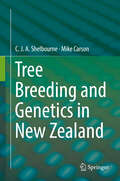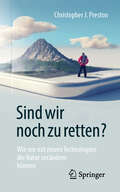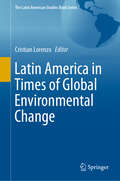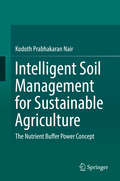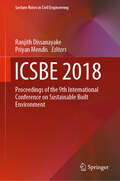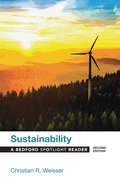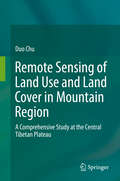- Table View
- List View
Beautiful Wreaths: 40 Handmade Creations throughout the Year
by Melissa SkidmoreCreate your own spring, summer, fall, or winter wreaths to welcome guests all year round. Why wait for Christmas to purchase and hang a wreath on your front door? Beckon family and friends into your home with your very own handmade, statement-making wreath centerpiece—all year round! In Melissa Skidmore’s childhood home, her front door was never without a gorgeous wreath to welcome a guest. Now, she hopes to bring the same creativity, warmth, and comfort into every family home. In the style of a rustic, modern farmhouse, Beautiful Wreaths provides forty wreath tutorials for every season. Choose from spring flowers, summer greenery, fall branches, and winter evergreens to craft your own stunning art piece: Fresh Succulent, Magnolia Garland, and Grapevine Bunny Wreaths for SpringFern and Moss, Artificial Floral, and Fourth of July Wreaths for SummerCornucopia, Corn Husk, and Pumpkin Wreaths for FallGreenery and Cinnamon Stick, Grapevine Snowman, and Toy Wreaths for WinterAnd more! Including non-traditional wreaths that use old rakes, vintage picture frames, chalkboard, and burlap bags, Beautiful Wreaths also features basic supplies and tips for wreath making, wreath form basics, and bow-tying tutorials. Full of beautiful photographs and whimsical illustrations, this is the perfect guide that belongs to any crafter’s and home decorator’s shelf.
Gardening Eden: How Creation Care Will Change Your Faith, Your Life, and Our World
by Michael AbbateBefore the snake,the apple,and the Ten Commandments,God created a garden..."Spiritual environmentalism" did not start out as an oxymoron-it was an invitation. Yet today, many believe God's first job description for humankind has been replaced by other "worthier pursuits". Why has this simple instruction become so controversial? How does one sort through all the mixed messages? Is changing our lives to save the world really our responsibility-or even possible?Gardening Eden invites you to consider a new, spiritual perspective to practical environmentalism. The question is not whether our souls find expression and inspiration in our incredible planet, but how best to preserve that fundamental connection. Green living is no longer a fad-simple lifestyle solutions are now available to everyone. Discover creation care as an act of worship and a call to deeper harmony with our Creator, our fellow gardeners, and our living Earth. Gardening Eden is the primer in how this shift will transform not only our world, but your very soul.From the Trade Paperback edition.
Lost in the Woods: A Survival Guide (Fountas & Pinnell LLI Purple #Level S)
by Kate ForsterText Elements <p><p> Genre: Procedural <p> Text Structures <p> Main: Temporal Sequence <p> Embedded: Cause/Effect, Problem/ Solution, Narrative, Question/ Answer <p> Text Features: table of contents, headings, photos, diagrams, captions, labels, sidebars, quiz, glossary
Up, Down and Turned Around
by Amy TaoHave you ever wondered how plants grow? How does the plant stem know to grow up while the roots grow down? This book will teach children how gravity affects plants with a fun experiment to grow their own beans!
The Magic Weaver
by Melissa Shaw-SmithAfter Conal’s family moves to the Irish countryside, an angry fairy curses their new home. Despite their beautiful new castle, the family can no longer feel any joy or happiness. When one of his sons, Finn, saves an injured dog, its magical owner decides to help the family. Will this stranger be able to lift the curse?
Indigenous Water Rights in Law and Regulation: Lessons from Comparative Experience (Cambridge Studies in Law and Society)
by Elizabeth Jane MacphersonIndigenous Water Rights in Law and Regulation responds to an unresolved question in legal scholarship: how are (or how might be) indigenous peoples' rights included in contemporary regulatory regimes for water. This book considers that question in the context of two key trajectories of comparative water law and policy. First, the tendency to 'commoditise' the natural environment and use private property rights and market mechanisms in water regulation. Second, the tendency of domestic and international courts and legislatures to devise new legal mechanisms for the management and governance of water resources, in particular 'legal person' models. This book adopts a comparative research method to explore opportunities for accommodating indigenous peoples' rights in contemporary water regulation, with country studies in Australia, Aotearoa New Zealand, Chile and Colombia, providing much needed attention to the role of rights and regulation in determining indigenous access to, and involvement with, water in comparative law.
Into the Volcano
by Charnan SimonDid you know that Hawaii is still being built, even today? Heidi learns all about how Kilauea, the most active volcano in the world, erupts and spills more lava every day, making the island grow! She also gets to visit Mauna Loa, the biggest mountain in the world. What do you think it might be like to visit?
The Swamp: The Everglades, Florida, and the Politics of Paradise
by Michael GrunwaldThe Everglades was once reviled as a liquid wasteland, and Americans dreamed of draining it. Now it is revered as a national treasure, and Americans have launched the largest environmental project in history to try to save it. The Swamp is the stunning story of the destruction and possible resurrection of the Everglades, the saga of man's abuse of nature in southern Florida and his unprecedented efforts to make amends. Michael Grunwald, a prize-winning national reporter for The Washington Post, takes readers on a riveting journey from the Ice Ages to the present, illuminating the natural, social and political history of one of America's most beguiling but least understood patches of land. The Everglades was America's last frontier, a wild country long after the West was won. Grunwald chronicles how a series of visionaries tried to drain and "reclaim" it, and how Mother Nature refused to bend to their will; in the most harrowing tale, a 1928 hurricane drowned 2,500 people in the Everglades. But the Army Corps of Engineers finally tamed the beast with levees and canals, converting half the Everglades into sprawling suburbs and sugar plantations. And though the southern Everglades was preserved as a national park, it soon deteriorated into an ecological mess. The River of Grass stopped flowing, and 90 percent of its wading birds vanished. Now America wants its swamp back. Grunwald shows how a new breed of visionaries transformed Everglades politics, producing the $8 billion rescue plan. That plan is already the blueprint for a new worldwide era of ecosystem restoration. And this book is a cautionary tale for that era. Through gripping narrative and dogged reporting, Grunwald shows how the Everglades is still threatened by the same hubris, greed and well-intentioned folly that led to its decline.
Valuing U.S. National Parks and Programs: America’s Best Investment
by Linda J. Bilmes John B. LoomisThis book provides the first comprehensive economic valuation of U.S. National Parks (including monuments, seashores, lakeshores, recreation areas, and historic sites) and National Park Service (NPS) programs. The book develops a comprehensive framework to calculate the economic value of protected areas, with particular application to the U.S. National Park Service. The framework covers many benefits provided by NPS units and programs, including on-site visitation, carbon sequestration, and intellectual property such as in education curricula and filming of movies/ TV shows, with case studies of each included. Examples are drawn from studies in Santa Monica Mountains National Recreation Area, Golden Gate National Recreation Area, Everglades National Park, and Chesapeake Bay. The editors conclude with a chapter on innovative approaches for sustainable funding of the NPS in its second century. The framework serves as a blueprint of methodologies for conservationists, government agencies, land trusts, economists, and others to value public lands, historical sites, and related programs, such as education. The methodologies are relevant to local and state parks, wildlife refuges, and protected areas in developed and developing countries as well as to national parks around the world. Containing a series of unique case studies, this book will be of great interest to professionals and students in environmental economics, land management, and nature conservation, as well as the more general reader interested in National Parks.
Soil Degradation and Restoration in Africa (Advances in Soil Science)
by Rattan Lal B. A. StewartSoil degradation is a widespread problem in Africa resulting in low agricultural productivity while demand for food continues to increase. Degradation is caused by accelerated erosion, acidification, contamination, depletion of soil organic matter and plant nutrients, and salinization. Food and nutritional security of the growing population of Africa can only be achieved if degraded soils are restored, and soils of agroecosystems are managed prudently and sustainably. This book describes the soils of Africa, processes of soil degradation, extent and severity of soil degradation, and the impacts of degradation processes on food and nutritional security.
Advanced Studies in Energy Efficiency and Built Environment for Developing Countries: Proceedings of IEREK Conferences: Improving Sustainability Concept in Developing Countries (ISCDC-2), Egypt 2017 and Alternative and Renewable Energy Quest in Architecture and Urbanism (AREQ-2), Spain 2017 (Advances in Science, Technology & Innovation)
by Chaham Alalouch Hassan Abdalla Emmanuel Bozonnet George Elvin Oscar CarracedoThis edited volume consists of three parts. It is a culmination of selected research papers presented at the second version of the international conference on Improving Sustainability Concept in Developing Countries (ISCDC) and the second version of the international conference on Alternative and Renewable Energy Quest in Architecture and Urbanism (AREQ), organized by IEREK in Egypt, 2017. It discusses major environmental issues and challenges which threaten our future. These include climate change impact, environmental deterioration, increasing demand for energy and new approaches for alternative renewable energy sources which became a necessity for survival. In addition to addressing the different environmental issues witnessed today, research presented in this book stressed on the need of sustainably shaping buildings and cities using renewable energy sources. Topics included in this book are (1) Resilience in the Built Environment, (2) Design for energy-efficient architecture and (3) Alternative and Renewable Energy Resources Quest in Architecture and Urbanism. The book is of interest to researchers and academicians who continuously aim to update their knowledge in these fields, as well as decision makers needing the enough knowledge to carry out the right decisions towards the benefit of the environment and society.
The Rise and Fall of the Carbon Dioxide Theory of Climate Change
by Rex J. FlemingThis book provides a complete review of the role of CO2 in the Earth’s atmosphere and reveals detailed information about the subject of climate change. Many different science disciplines are visited and discussed and each area is introduced with a brief summary written to appeal to a broader audience. The logic of CO2 involvement in changing the climate is investigated from every perspective: reviewing the historical data record of Ice Ages with vast ice sheets, noting the interglacial periods of little or no ice, examining in further detail the 20th century data record and evaluating the radiation role of CO2 in the atmosphere. The radiation calculations, using the appropriate equations and data are reviewed in great detail. The results of this review and examination reveal no role of CO2 in any change of the Earth’s climate. Disclaimer: The views expressed in this book belong solely to the author.
In Pursuit of Prosperity: U.S Foreign Policy in an Era of Natural Resource Scarcity
by David ReedIn Pursuit of Prosperity provides a much needed exploration of the evolution of environmental sustainability in U.S. foreign policy. Through expert analysis of nine countries and regions of strategic importance, David Reed and his stellar team of experts in foreign policy and environmental affairs identify emerging threats to the prosperity and national security of the United States. They assert that U.S. foreign policy must shift away from its 100-year-old focus on obtaining energy and mineral inputs for the industrial economy. In the new millennium, U.S. foreign policy must be geared toward ensuring the prosperity of the country’s trading and political partners around the globe. To the degree that our partners’ economies and social stability are threatened by the natural resource scarcities and environmental change unfolding within their borders and in neighboring countries, threats to U.S. prosperity and national security increase proportionately. Directed to U.S. foreign policy makers, the intelligence and security communities, and influential think tanks and research organizations, the book proposes specific recommendations the U.S. government should embrace to respond to the disruption of global supply chains, social instability in partner countries, disruptive impacts on regional relations, and expansion of illegal trade and criminal networks. This unique focus establishes In Pursuit of Prosperity as a seminal work in understanding the challenges facing the United States in this period of global environmental change.
The Governance of Rangelands: Collective Action for Sustainable Pastoralism
by Pedro M. Herrera Jonathan Davies Pablo Manzano BaenaRangelands are large natural landscapes that can include grasslands, shrublands, savannahs and woodlands. They are greatly influenced by, and often dependent on, the action of herbivores. In the majority of rangelands the dominant herbivores are found in domestic herds that are managed by mobile pastoralists. Most pastoralists manage their rangelands communally, benefitting from the greater flexibility and seasonal resource access that common property regimes can offer. As this book shows, this creates a major challenge for governance and institutions. This work improves our understanding of the importance of governance, how it can be strengthened and the principles that underpin good governance, in order to prevent degradation of rangelands and ensure their sustainability. It describes the nature of governance at different levels: community governance, state governance, international governance, and the unique features of rangelands that demand collective action (issues of scale, ecological disequilibrium and seasonality). A series of country case studies is presented, drawn from a wide spectrum of examples from Africa, the Middle East, Central Asia, Europe and North America. These provide contrasting lessons which are summarised to promote improved governance of rangelands and pastoralist livelihoods.
Evaluating Environment in International Development
by Juha I. Uitto Yolanda Kakabadse Indran A. NaidooMore than twenty years after the Earth Summit was held in Rio de Janeiro in 1992, both national and international actors in governmental and nongovernmental fields are still searching for insights into how sustainable development can be advanced and environmental concerns incorporated into the development agenda more effectively. Moreover, climate change has emerged as a preeminent challenge to both the environment and to development. Evaluating Environment in International Development provides international perspectives and in-depth knowledge of evaluating development and the environment and applies evaluation knowledge to climate change mitigation and adaptation. The book focuses on the approaches and experiences of leading international organizations, not-for-profits, and multilateral and bilateral aid agencies to illustrate how systematic evaluation is an essential tool for providing evidence for decision-makers. It provides novel and in-depth perspectives on evaluating environment and sustainability issues in developing countries. Moving beyond projects and programmes, it considers aspects such as evaluating normative work on the environment and evaluating environmental consequences of economic and social development efforts. This original collection should be of interest to scholars of environment studies, development studies, international relations, sustainable development and evaluation, as well as practitioners in international organizations and development and environmental NGOs.
Planning for Ecosystem Services in Cities (SpringerBriefs in Environmental Science)
by Davide Geneletti Chiara Cortinovis Linda Zardo Blal Adem EsmailThis open access book presents current knowledge about ecosystem services (ES) in urban planning, and discusses various urban ES topics such as spatial distribution of urban ecosystems, population distribution, and physical infrastructure properties. The book addresses all these issues by: i) investigating to what extent ecosystem services are currently included in urban plans, and discussing what is still needed to improve planning practice; ii) illustrating how to develop ecosystem services indicators and information that can be used by urban planners to enhance plan design; iii) demonstrating the application of ES assessments to support urban planning processes through case studies; and iv) reflecting on criteria for addressing equity in urban planning through ecosystem service assessments, by exploring issues associated with the supply of, the access to and demand for ES by citizens. Through fully worked out case studies, from policy questions, to baseline analysis and indicators, and from option comparison to proposed solutions, the book offers readers detailed and accessible coverage of outstanding issues and proposed solutions to better integrate ES in city planning. The overall purpose of the book is to provide a compact reference that can be used by researchers as a key resource offering an updated perspective and overview on the field, as well as by practitioners and planners/decision makers as a source of inspiration for their activity. Additionally, the book will be a suitable resource for both undergraduate and post-graduate courses in planning and geography.
Collateral Values: The Natural Capital Created by Landscapes of War (Landscape Series #25)
by Todd R. Lookingbill Peter D. SmallwoodThis book explores the unanticipated benefits that may arise after wars and conflicts, showing how the preservation of battlefields and the establishment of borderlands can create natural capital in the former landscapes of war. The editors call this Collateral Value, in contrast to the collateral damage that war inflicts upon infrastructure, natural capital, and human capital. The book includes case studies recounting successes and failures, opportunities and risks, and ambitious proposals. The book is organized in two sections. The first visits U.S., English, and French battlefield sites dating from medieval England to World War I. The second explores borderlands located on several continents, established to end or prevent conflict. Both of these can create value beyond their original purpose, by preserving natural areas and restoring biodiversity. Among the topics covered are: · Registering English Battlefields · Old forts and new amenities in the Southern Plains of the U.S. · Verdun, France, and the conservation of WWI cultural and natural heritage · Conservation lessons learned in the Cordillera del Condor Corridor of the Andes mountains · Korea’s DMZ and its nature preserve · Wakhan National Park, a mountainous buffer area between Afghanistan and Pakistan The book examines state-of-the-art applications of landscape ecology, including methods for change detection, connectivity analysis, and the quantification of ecosystem services. Also included is a chapter on a creative proposal for “Guantánamo 2.0,” which would transform the Gitmo detention facility into a peace park and ecological research center. A concluding chapter appraises the past, present, and future of Collateral Values.Collateral Values: The Natural Capital Created by Landscapes of War benefits a broad audience of advanced undergraduate and graduate students, researchers, and practicing professionals.
Climate Change and Arctic Security: Searching for a Paradigm Shift
by Lassi Heininen Heather Exner-PirotThis book assesses the construction of security in the context of climate change, with a focus on the Arctic region. It examines and discusses changes in the security premises of the Arctic states, from traditional security to environmental and human security. In particular, the book explores how climate change impacts security discourses and premises as well as theoretically discussing the possibility for another change, from circumpolar stability into peaceful change. Chapters cover topics such as the ethics of climate change in the arctic, China’s emerging power and influence on arctic climate security, the discursive transformation of the definition of security and the intersection between urban, climate and Arctic studies. The book concludes with the question of whether a paradigm shift in our understanding of traditional security is possible, and whether it is already occurring in the Arctic.
Tree Breeding and Genetics in New Zealand
by C.J.A. Shelbourne Mike CarsonDothistroma pini changed New Zealand commercial forestry dramatically. Tree breeding became concentrated on a very few species and development of selection methods and breeding strategies changed in response to the new challenges. Tree-Breeding and Genetics in New Zealand provides a critical historical account of the work on provenance research and tree breeding, often with the wisdom of hindsight, and it tracks the development of breeding strategy, especially for P. radiata, Douglas-fir and the most important eucalypt species, E. regnans, E. fastigata and E. nitens. The book is a compendium of abstracts and summaries of all publications and reports on tree improvement in New Zealand since the early 1950s, with added critical comment by the author on much of the work. It is intended for other tree breeders internationally, for interested NZ foresters and for graduate students studying genetics and tree breeding.
Sind wir noch zu retten?: Wie wir mit neuen Technologien die Natur verändern können
by Christopher J. PrestonNanotechnologie, synthetische Biologie, Wiedererweckung ausgestorbener Arten und Geoengineering – werden Menschen die Natur in Zukunft mit solchen Methoden grundlegend umgestalten? Man könnte es sich vorstellen.Auf der Erde gibt es keinen von Menschen unberührten Ort mehr – das hat wohl jeder schon einmal gehört. Aber die Bedeutung dieser Tatsache erschöpft sich nicht in Statistiken, die Gletscherschmelze und Artensterben dokumentieren. Vielmehr kennzeichnet sie den Beginn einer neuen Epoche der Erdgeschichte. Und das Auffälligste an diesem Synthetischen Zeitalter, so Christopher Preston, sind nicht nur die Auswirkungen des Menschen als solche, sondern die Veränderungen, die wir von nun an gezielt und absichtlich herbeiführen werden. Neue Technologien werden uns die Macht verleihen, viele grundlegende Abläufe der Natur selbst in die Hand zu nehmen. Damit verlassen wir nicht nur das Holozän und treten ins Anthropozän ein; wir lassen auch eine Zeit hinter uns, in der globaler Wandel nicht nur die unbeabsichtigte Folge einer ungezügelten Industrialisierung ist. Mit einer von Ingenieuren und Technikern gestalteten Welt beginnt das erste Synthetische Zeitalter unseres Planeten.Preston beschreibt eine Reihe von Technologien, die den „Stoffwechsel“ der Erde umgestalten werden: Nanotechnologie gibt den natürlichen Formen der Materie eine neue Struktur; „molekulare Produktion“ eröffnet unzählige neue Anwendungsmöglichkeiten; synthetische Biologie erlaubt es uns, Genome nicht nur zu lesen, sondern auch aufzubauen; „biologische Mini-Maschinen“ überflügeln die Evolution; Arten werden umgesiedelt und wieder zum Leben erweckt; und mit Geoengineering kann man die Sonnenstrahlung mit Vulkandunst abschirmen, die Temperaturen auf der Erde durch hellere Wolken senken und mit künstlichen Bäumen, die Kohlenstoff aus Wind gewinnen, das CO2 aus der Atmosphäre beseitigen.Was bedeutet es, wenn Menschen die Erde nicht nur verwalten, sondern auch grundlegend umgestalten? Und wem sollten wir vertrauen, wenn es darum geht, über die Umrisse unserer synthetischen Zukunft zu entscheiden? Solche Fragen sind zu wichtig, als dass man sie den Ingenieuren überlassen sollte.
Latin America in Times of Global Environmental Change (The Latin American Studies Book Series)
by Cristian LorenzoThis volume discusses the challenges of Latin America in global environmental geopolitics. Written by leading experts, this book brings together Latin American research on global environmental change. They cover a range of topics such as climate change, water, forest and biodiversity conservation connected with science policies, public opinion, priorities of international funds, and international politics of Latin American countries. The book describes the discrepancy between the international priorities and the regional needs or country interests. It includes several case studies and analyses the cooperation in multilateral negotiations on climate change. It also offers a synthesis of debates around global environmental changes and Latin American politics, which the authors have previously promoted in different academic events in South America, including in Santiago de Chile in Chile, and Buenos Aires and Ushuaia in Argentina.This book assesses the environmental problems from different perspectives, highlights the scientific development in the environmental changes affecting Latin America and offers a new view on geopolitics to help face those issues. Specialist readers in international relations, political sciences, environmental sciences, geography and geopolitics will appreciate this up-to-date examination of Latin America and the global environmental change.
Intelligent Soil Management for Sustainable Agriculture: The Nutrient Buffer Power Concept
by Kodoth Prabhakaran NairThis book conceptualizes a revolutionary idea based on a mechanistic-mathematical model in which the “Buffer Power” of the principal and problematic nutrients like phosphorus, potassium and zinc is quantified. This is achieved by using either a very sophisticated technique, electro-ultra-filtration, or a simple adsorption-desorption equilibrium technique, and by integrating the “Buffer Power” of the nutrient in question into the computations, accurate fertilizer recommendations are made. This technique was field tested across Europe, (Germany and Belgium), Africa (The Republic of Cameroon), and Asia (both Central Asia- Turkey and South Asia-India), during a period of three decades in test crops, such as, summer rye (Secale cereale), maize (Zea mays), wheat (Triticum aestivum), white clover (Trifolium repens), a highly nutritious and palatable fodder crop for Africa, black pepper (Piper nigrum) and cardamom (Elettaria cardamomum). Remarkable precision in predictability of plant uptake of phosphorus, potassium and zinc was obtained employing the technique.“The Nutrient Buffer Power Concept” project was shortlisted for the very prestigious U.S. $1 Million Rolex Awards For Enterprise of The Rolex Foundation, Geneva, Switzerland, for its outstanding originality and quality from more than 3500 nominations worldwide and is the only project chosen for this very coveted distinction from the Asian continent.
ICSBE 2018: Proceedings of the 9th International Conference on Sustainable Built Environment (Lecture Notes in Civil Engineering #44)
by Ranjith Dissanayake Priyan MendisThis book highlights current research and development in the area of sustainable built environments, currently one of the most important disciplines in civil engineering. It covers a range of topics, including sustainable construction and infrastructures, waste and wastewater management, enhanced sustainability, renewable and clean energy, sustainable materials and industrial ecology, building automation and virtual reality, and impact of climate change. As such it provides vital insights into responsible urbanization practices, and new tools and technologies in civil engineering that can mitigate the negative effects of the built environment.
Sustainability (Second Edition): A Bedford Spotlight Reader
by Christian R. WeisserSustainability explores questions around the central concept of sustainability: What are its foundations and politics? How do crises challenge sustainability? How is sustainability connected to local and transnational environments? How is sustainability connected to tourism and recreation? <P><P>Readings by a range of ecologists, urban planners, philosophers, geographers, reporters, artists, and ordinary citizens take up these questions and more. Questions and assignments for each selection provide a range of activities for students. The website for the Spotlight Series offers comprehensive instructor support with sample syllabi and additional teaching resources. <P><P>The Bedford Spotlight Reader Series is an exciting line of single-theme readers, each reflecting Bedford’s trademark care and quality. An editorial board of a dozen compositionists at schools with courses focusing on specific themes assists in the development of the series. Each reader collects thoughtfully chosen selections sufficient for an entire writing course—about 35 pieces—to allow instructors to provide carefully developed, high-quality instruction at an affordable price. <P><P>Bedford Spotlight Readers are designed to help students from all majors make sustained inquiries from multiple perspectives, opening up topics such as money, food, border crossings, music, humor, subcultures, happiness, monsters, sustainability, and gender to critical analysis. The readers are flexibly arranged in thematic chapters, with each chapter focusing in depth on a different facet of the central topic. The website for the Spotlight Series offers comprehensive instructor support with sample syllabi and additional teaching resources.
Remote Sensing of Land Use and Land Cover in Mountain Region: A Comprehensive Study at the Central Tibetan Plateau
by Duo ChuThis book presents the spatial and temporal dynamics of land use and land cover in the central Tibetan Plateau during the last two decades, based on various types of satellite data, long-term field investigation and GIS techniques. Further, it demonstrates how remote sensing can be used to map and characterize land use, land cover and their dynamic processes in mountainous regions, and to monitor and model relevant biophysical parameters.The Tibetan Plateau, the highest and largest plateau on the Earth and well known as “the roof of the world,” is a huge mountainous area on the Eurasian continent and covers millions of square kilometers, with an average elevation of over 4000 m. After providing an overview of the background and an introduction to land use and land cover change, the book analyzes the current land use status, dynamic changes and spatial distribution patterns of different land-use types in the study area, using various types of remotely sensed data, digital elevation models and GIS spatial analysis methods to do so. In turn, it discusses the main driving forces, based on the main physical environment variables and socioeconomic data, and provides a future scenario analysis of land use change using a Markov chain model. Given its scope, it provides a valuable reference guide for researchers, scientists and graduate students working on environmental change in mountainous regions around the globe, and for practitioners working at government and non-government agencies.
